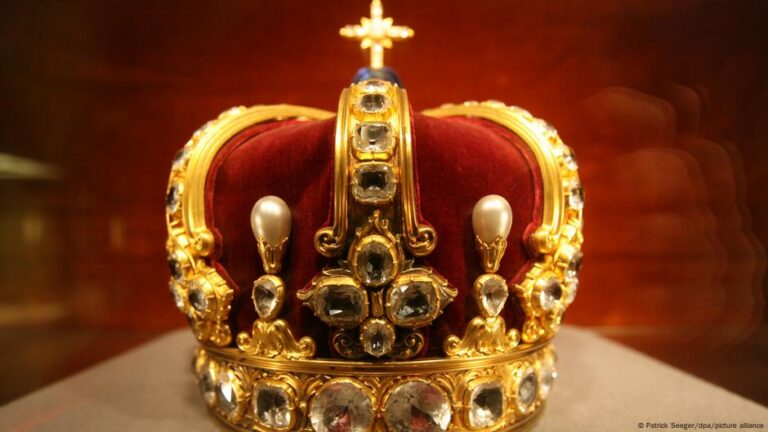An almost century-long dispute in Germany is coming to an end.
The House of Hohenzollern — a German noble family to which the last German Emperor, Wilhelm II, also belonged — had long laid claim to various objects in German museums. They had also demanded millions in compensation for expropriated palaces and inventory.
The whole thing went to court — until Georg Friedrich Prince of Prussia, the great-great-grandson of the last German emperor, finally changed the aristocratic house’s strategy in 2023. He withdrew the compensation claims and thus cleared the way for out-of-court negotiations. The talks began in late 2024, resulting in the newly-reached agreement.
Works of art to remain in museums
The new German Minister of State for Culture Wolfram Weimer (CDU) and Georg Friedrich Prince of Prussia had announced the breakthrough back in May 2025.
The federal government and the states of Berlin and Brandenburg had reached an agreement with the former ruling house of Hohenzollern to set up the non-profit “Hohenzollern Art Foundation” to manage the previously reclaimed art and cultural objects.
Now that the supervisory bodies of the Prussian Cultural Heritage Foundation and the German Historical Museum have also given their approval, the agreement has been signed and sealed.
According to Weimer, the public will be the biggest winner. The collections that include around 3,000 objects will now feature in the German Historical Museum, along with museums run by the Prussian Palaces and Gardens Foundation Berlin-Brandenburg, and the Prussian Cultural Heritage Foundation.
The new foundation will also manage the inventory — furniture, tableware and paintings — from around 70 palaces, villas and other properties in Berlin and Potsdam that were owned or used by the Hohenzollern family until 1945.
There are also objects belonging to the family that were confiscated as early as 1918, after the end of the monarchy.
The expropriation of the ‘Junkers’
At the end of World War II, Soviet troops conquered the former German territories east of the Elbe River and with them the bulk of the Hohenzollern territories.
The Soviet Union regarded the “Junkers” — the land-owning nobility — as the class enemy and a pillar of the Nazi system. So in 1945, all noble houses in the Soviet occupation zone were expropriated without compensation.
More than four decades later, the Berlin Wall fell and Germany was reunited. From one minute to the next, many former Hohenzollern castles and estates were once again on the Federal Republic’s soil.
But the German Unification Treaty in 1990 stated that the land reform of 1945 would not be reversed, meaning the Hohenzollerns had to write off their old properties in the east.
Some 30 years later, the heirs of the last monarch demanded millions in compensation from the German state and the restitution of cultural assets — in vain. So the matter went to court.
Did the Hohenzollerns ‘aid and abet’ the Nazis?
This question played a central role in the compensation dispute: Had representatives of the House of Hohenzollern colluded with the National Socialists who ruled Germany between 1933 and 1945? Specifically, had the heirs of the last German Emperor, Wilhelm II, who abdicated in 1918, “significantly supported” National Socialism?
And what role did the son of the last monarch and former Crown Prince Wilhelm of Prussia play between the world wars? Did he help the Nazis come to power in order to re-establish the monarchy?
The so-called “Compensation Act” of 1994, which regulates the compensation of landowners whose property was expropriated in the East in 1945, states that anyone who “significantly aided” Hitler and the Nazis has no right to compensation.
In fact, historical documents prove Wilhelm’s ties to Hitler, with photos and films showing the former crown prince with the dictator and other Nazi leaders. However, Wilhelm’s hopes that the Nazis would crown him the new emperor were never realized and historians continue to debate Wilhelm’s role in the Nazi state.
Seeking proximity with Hitler
In their biographies, two German historians Lothar Machtan (“The Crown Prince and the Nazis”) and Stephan Malinowski (“The Hohenzollerns and the Nazis”) describe the crown prince as a radical anti-democrat who admired Mussolini and sought proximity to Hitler. His mission was to restore the monarchy.
Malinowski and his colleague Peter Brandt concluded that Wilhelm of Prussia’s behavior had “considerably aided and abetted” the establishment and consolidation of the National Socialist regime.
In fact, the ex-crown prince called for the election of Hitler in the 1932 German presidential election. He later boasted to Hitler that he had procured him two million votes.
Wilhelm also publicly demonstrated solidarity with the new elites. “The symbolic capital of the Hohenzollerns was very important for the Nazis in 1932/33, even if the crown prince had his own agenda in the process,” said Jacco Pekelder, a historian from Münster, in a television interview.”
Debate ongoing but settlement reached
The editors of the anthology “Die Hohenzollerndebatte” (The Hohenzollern Debate), published in 2021, casted their doubt on these fascist ties.
Historian Frank-Lothar Kroll attested to Wilhelm’s “rather marginal commitment” to the Nazis. He may have pandered to Hitler, but he did not share his totalitarian ideology.
For decades, hordes of lawyers, politicians and historians dealt with the restitution and compensation claims of the descendants of Wilhelm of Prussia. Now a settlement finally seems to have been reached, and the public could benefit the most.
This is an updated version of an article originally written in German.


